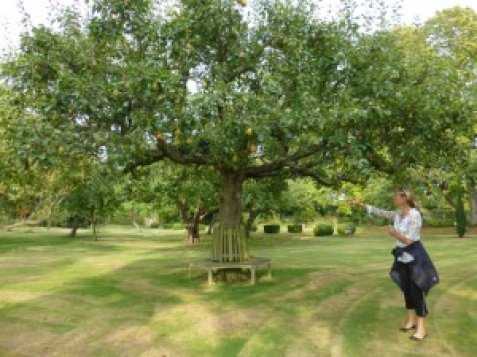 Fruit trees are magnificent and lovely even without the eating. Garden designers hunt around for architectural plants and most fruit trees have this this quality in spadefuls. A few winters ago, I was tasked to renovate a small old orchard and my tree surgeon, who is a trained artist, pruned the old trees. Out with dead wood and years of neglect to reveal trunks and branches of sculptural beauty.
Fruit trees are magnificent and lovely even without the eating. Garden designers hunt around for architectural plants and most fruit trees have this this quality in spadefuls. A few winters ago, I was tasked to renovate a small old orchard and my tree surgeon, who is a trained artist, pruned the old trees. Out with dead wood and years of neglect to reveal trunks and branches of sculptural beauty. 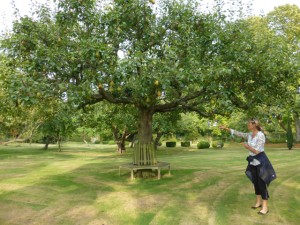 Take a look at the picture of the old pear tree being admired by a friend. As trees, pears tend to be big, upright and rather military. I’m fairly certain that in its early years, this specimen must have had its branches wired down. Planting up a new orchard is up there on my list of unlikely things to aspire to along with running the marathon du Sable or training up a racehorse. If you already own one (orchard, that is) and have meadow-long grass under the trees with free-ranging chickens, I am envious. But for those starting from scratch there are several secrets to success. Rootstock, pollination groups and your own particular soil and microclimate. Lets demystify these terms. Rootstocks are chosen from sturdy disease-free parent wood and then the particular cultivar of pear, apple, cherry and the rest are grafted on to this plant material. Look into buying apple trees and you will get a series of numbers that sound like they have been lifted from a road atlas. Most vigorous is MM111 and by scale descending to the most dwarfing, the M27. Use of rootstocks took off in the last century and it is all about controlling the vigour of your tree. This adds up twice over as the new grower can have more trees per acreage and harvest the fruit without clambering up ladders.
Take a look at the picture of the old pear tree being admired by a friend. As trees, pears tend to be big, upright and rather military. I’m fairly certain that in its early years, this specimen must have had its branches wired down. Planting up a new orchard is up there on my list of unlikely things to aspire to along with running the marathon du Sable or training up a racehorse. If you already own one (orchard, that is) and have meadow-long grass under the trees with free-ranging chickens, I am envious. But for those starting from scratch there are several secrets to success. Rootstock, pollination groups and your own particular soil and microclimate. Lets demystify these terms. Rootstocks are chosen from sturdy disease-free parent wood and then the particular cultivar of pear, apple, cherry and the rest are grafted on to this plant material. Look into buying apple trees and you will get a series of numbers that sound like they have been lifted from a road atlas. Most vigorous is MM111 and by scale descending to the most dwarfing, the M27. Use of rootstocks took off in the last century and it is all about controlling the vigour of your tree. This adds up twice over as the new grower can have more trees per acreage and harvest the fruit without clambering up ladders. 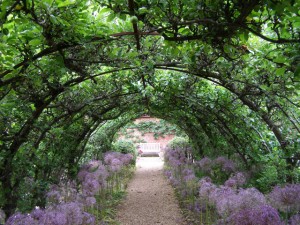 Pollination is the next on the list to grapple with. A few fruit trees are self-fertile but in the main they will need to have the company of other members of the family near at hand (for instance a crab-apple). Weirdly, two trees of the same type won’t cross-fertilise. Blossom times need to be checked for compatibility so that the bees move the pollen around and fertilise each plant to set fruit. Fruit tree nurseries will list the different pollination groups. Soil and microclimate - It’s enough to say that type of soil will influence your choice of tree and the size of rootstock as well. For this reason, it is a very good idea to source your fruit trees locally - the nursery grower will know the climate and what does well. Then there is the eating - I planted a series of pears two years back and made sure to choose a harvesting succession of fruit. You may have an apple store but a beady friend of mine comes up with wizened apples from her storage in the deep mid winter. They are curious specimens that look as if they have been through the natura morta lens of Sam Taylor Wood. Don’t overlook the alternative to an orchard which is the wonder of growing restricted forms of fruit. Years ago a travel through the plain of Lombardy showed 2 dimensional fruit trees marching across the landscape like an army of mercenaries. En masse they bewilder but used judiciously, here is a way to divide up your garden and create a living wall. In our garden we have put in heavy posts and strong wire kept tensioned by straining bolts at intervals along to support apples and pears grown as cordons. These are perfect for a small place as the oblique trunks are spaced 60-80 cms apart. The trees are kept neat, small and productive by restrictive pruning in high summer. It makes an attractive living fence and clematis can be planted to co-habit with the fruit.
Pollination is the next on the list to grapple with. A few fruit trees are self-fertile but in the main they will need to have the company of other members of the family near at hand (for instance a crab-apple). Weirdly, two trees of the same type won’t cross-fertilise. Blossom times need to be checked for compatibility so that the bees move the pollen around and fertilise each plant to set fruit. Fruit tree nurseries will list the different pollination groups. Soil and microclimate - It’s enough to say that type of soil will influence your choice of tree and the size of rootstock as well. For this reason, it is a very good idea to source your fruit trees locally - the nursery grower will know the climate and what does well. Then there is the eating - I planted a series of pears two years back and made sure to choose a harvesting succession of fruit. You may have an apple store but a beady friend of mine comes up with wizened apples from her storage in the deep mid winter. They are curious specimens that look as if they have been through the natura morta lens of Sam Taylor Wood. Don’t overlook the alternative to an orchard which is the wonder of growing restricted forms of fruit. Years ago a travel through the plain of Lombardy showed 2 dimensional fruit trees marching across the landscape like an army of mercenaries. En masse they bewilder but used judiciously, here is a way to divide up your garden and create a living wall. In our garden we have put in heavy posts and strong wire kept tensioned by straining bolts at intervals along to support apples and pears grown as cordons. These are perfect for a small place as the oblique trunks are spaced 60-80 cms apart. The trees are kept neat, small and productive by restrictive pruning in high summer. It makes an attractive living fence and clematis can be planted to co-habit with the fruit. 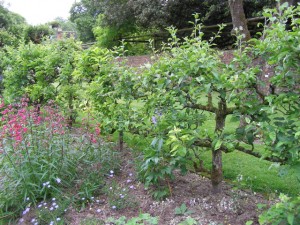 Espaliering is a way to make a fence - say, round a vegetable garden. You can have as many tiers of fruit as you want. At Cranborne Manor they use espaliered apples at the back of the perennial borders. Or perhaps you might have greater ambitions: what about a pear tunnel? The metal supports can be made by your blacksmith. I have seen this done both at Cranborne and at Batemans, Kipling’ s garden in Sussex. Or you could take flight into the invention of crinolene shaped trees as seen at West Dean gardens in the image at the top of this post. The last mention is of fruit trees in pots. Lemons in Italy north of Rome are taken indoors and then trolleyed out into the garden in May. The effect is wonderful and I have long been harbouring the urge to grow apricots like this. Two drawbacks, it is better to have an orangery for the overwintering and a team of burly gardeners to do the moving.
Espaliering is a way to make a fence - say, round a vegetable garden. You can have as many tiers of fruit as you want. At Cranborne Manor they use espaliered apples at the back of the perennial borders. Or perhaps you might have greater ambitions: what about a pear tunnel? The metal supports can be made by your blacksmith. I have seen this done both at Cranborne and at Batemans, Kipling’ s garden in Sussex. Or you could take flight into the invention of crinolene shaped trees as seen at West Dean gardens in the image at the top of this post. The last mention is of fruit trees in pots. Lemons in Italy north of Rome are taken indoors and then trolleyed out into the garden in May. The effect is wonderful and I have long been harbouring the urge to grow apricots like this. Two drawbacks, it is better to have an orangery for the overwintering and a team of burly gardeners to do the moving. 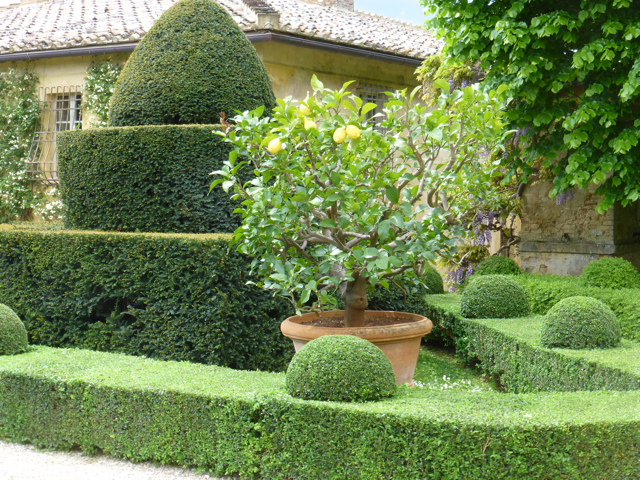 This first appeared as an article in Essential Suffolk, January 2015
This first appeared as an article in Essential Suffolk, January 2015
